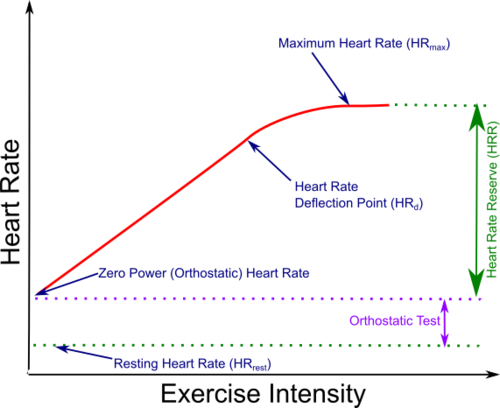Heart Rate Monitor
From Fellrnr.com, Running tips
Revision as of 14:59, 7 June 2014 by User:Fellrnr (User talk:Fellrnr | contribs)

A simplified chart of Heart Rate against exercise intensity showing Maximum Heart Rate, Heart Rate Reserve, Resting Heart Rate and Heart Rate Deflection.
There are three common methods of measuring Heart Rate:
- Electrical. The most common approach for measuring Heart Rate during exercise is to use a strap across the chest to record the electrical impulses from the heart, which is a highly accurate technique. The strap is a mild inconvenience, but most modern straps are fabric and reasonably comfortable for running distance up to around 50 miles. For longer distances, chaffing from the heart rate strap can be an issue. A good running watch will include not only a heart rate monitor, but also provide the ability to transfer a recording of the heart rate to a computer for detailed analysis and recording.
- Optical. An emerging technique for measuring Heart Rate is to use optically measure the filling of the capillaries under the skin. This technique is accurate enough to give a reading overall heart rate, but current devices are not accurate enough for measuring Heart Rate Variability. (This is the technique used by a Pulse Oximeter, but they don't work during exercise and are only useful for Resting Heart Rate.)
- Pressure. A blood pressure meter will detect heart rate from the pressure changes in the cuff. However, this is not suitable for use during exercise.